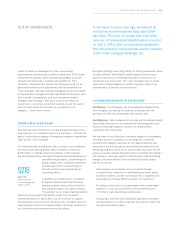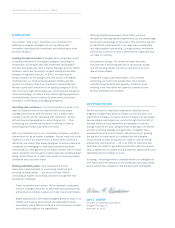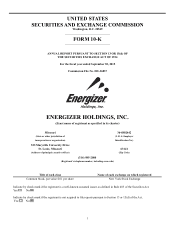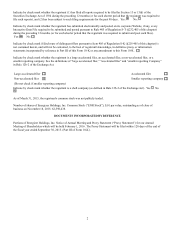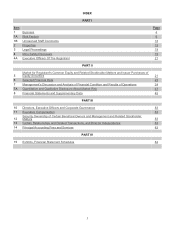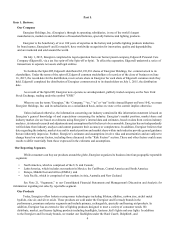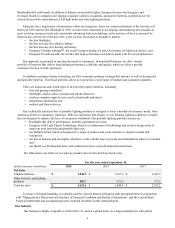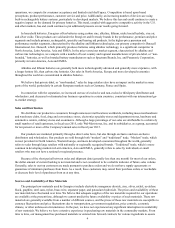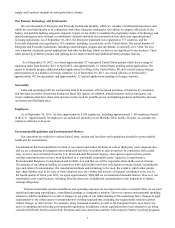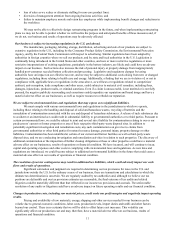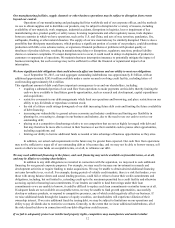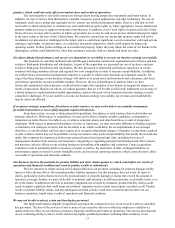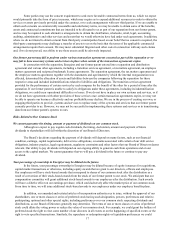Energizer 2015 Annual Report Download - page 13
Download and view the complete annual report
Please find page 13 of the 2015 Energizer annual report below. You can navigate through the pages in the report by either clicking on the pages listed below, or by using the keyword search tool below to find specific information within the annual report.9
The success of our brands can suffer if our marketing plans or new product offerings do not improve, or have a
negative impact on, our brands’ image or ability to attract and retain consumers. Additionally, if claims made in our
marketing campaigns become subject to litigation alleging false advertising, which is common in our industry, it could
damage our brand, cause us to alter our marketing plans in ways that may materially and adversely affect sales, or result in
the imposition of significant damages against us. Further, a boycott or other campaign critical of us, through social media
or otherwise, could negatively impact our brands’ reputation and consequently our products’ sales.
Loss of any of our principal customers could significantly decrease our sales and profitability.
Generally, sales to our top customers are made pursuant to purchase orders and we do not have supply agreements
or guarantees of minimum purchases from them. As a result, these customers may cancel their purchase orders or
reschedule or decrease their level of purchases from us at any time. The loss or a substantial decrease in the volume of
purchases by any of our top customers would harm our sales and profitability. Additionally, increasing retailer customer
concentration could result in reduced sales outlets for our products, as well as greater negotiating pressures and pricing
requirements on us.
Sales of our battery products may be impacted by further changes in technology and device trends, which could impair
our operating results and growth prospects.
We believe an increasing number of devices are using built-in battery systems, particularly in developed markets,
leading to a declining volume trend in the battery category, which we expect will continue. This has and will likely
continue to have a negative impact on the demand for primary batteries. This trend has and will continue to put additional
pressure on results going forward, both directly through reduced consumption and indirectly as manufacturers
aggressively price and promote their products to seek to retain market share or gain battery shelf space. Development and
commercialization of new battery or device technologies not available to us could also negatively impact our results and
prospects.
We are subject to risks related to our international operations, including currency fluctuations, which could adversely
affect our results of operations.
Our business is currently conducted on a worldwide basis, with more than half of our sales in fiscal year 2015
arising from foreign countries, and a significant portion of our production capacity and cash located overseas.
Consequently, we are subject to a number of risks associated with doing business in foreign countries, including:
• the possibility of expropriation, confiscatory taxation or price controls;
• the inability to repatriate foreign-based cash for strategic needs in the U.S., either at all or without incurring
significant income tax and earnings consequences, as well as the heightened counterparty, internal control and
country-specific risks associated with holding cash overseas;
• the effect of foreign income taxes, value-added taxes and withholding taxes, including the inability to recover
amounts owed to us by a government authority without extended proceedings or at all;
• the effect of the U.S. tax treatment of foreign source income and losses, and other restrictions on the flow of capital
between countries;
• adverse changes in local investment, local employment, local training or exchange control regulations;
• restrictions on and taxation of international imports and exports;
• currency fluctuations, including the impact of hyper-inflationary conditions in certain economies, particularly where
exchange controls limit or eliminate our ability to convert from local currency;
• political or economic instability, government nationalization of business or industries, government corruption
and civil unrest, including political or economic instability in the countries of the Eurozone, Egypt and the
Middle East and Latin America;
• legal and regulatory constraints, including tariffs and other trade barriers;
• difficulty in enforcing contractual and intellectual property rights; and
• a significant portion of our sales are denominated in local currencies but reported in U.S. dollars, and a high
percentage of product costs for such sales are denominated in U.S. dollars. Therefore, although we may hedge a
portion of the exposure, the strengthening of the U.S. dollar relative to such currencies can negatively impact our
reported sales and operating profits.
In recent months, the U.S. dollar has strengthened significantly against most currencies. We expect that our near
term total segment profit will continue to be impacted by these adverse currency movements.
A failure of a key information technology system could adversely impact our ability to conduct business.
We rely extensively on information technology systems, including some that are managed by third-party
service providers, in order to conduct business. These systems include, but are not limited to, programs and processes


